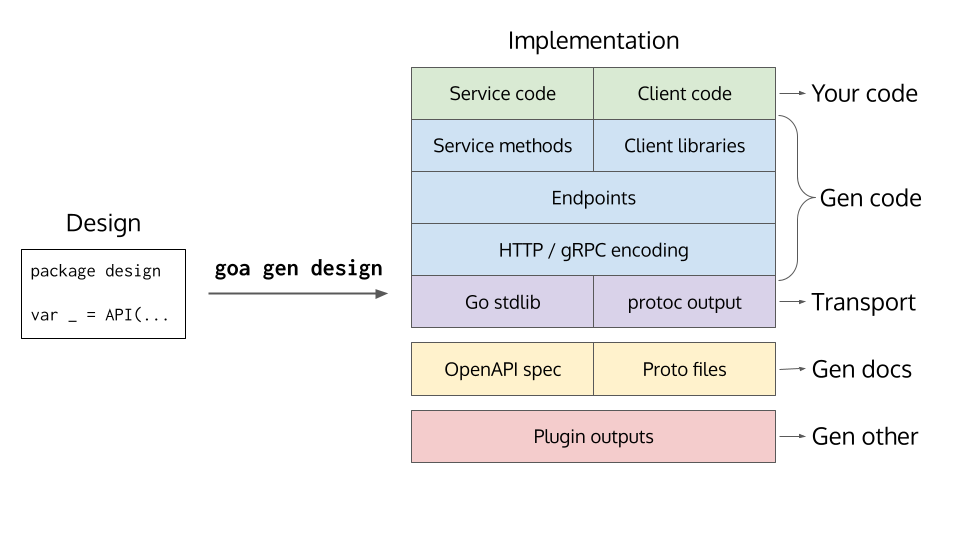What is Goa?
Now that you understand why Goa can transform your API development, let’s explore how it works in practice. At its core, Goa is a design-first framework that revolutionizes how you build microservices and APIs in Go through an elegant domain-specific language (DSL) that lets you define your entire service architecture in a clear, maintainable way.
The Power of Design-First Development
The design-first approach you’ve just learned about comes to life through Goa’s expressive DSL. This powerful language lets you describe your entire API architecture in a way that both humans and machines can understand, turning high-level service definitions into production-ready code.
Key Design Elements
**Services & Methods** Define the core behaviors your API provides with clean, readable syntax. Every endpoint, every operation, and every interaction is clearly specified. **Data Structures** Describe your payloads, results, and error types with type-safe precision. Goa ensures your data flows exactly as designed, from input validation to response formatting. **Transport Mappings** Specify how your services are exposed - HTTP, gRPC, or both. Switch between protocols or support multiple transports without changing your core service logic.From these definitions, Goa generates production-ready code that handles all the complex transport logic, letting you focus purely on your business implementation. No more tedious boilerplate or error-prone manual translations between your API design and implementation.
Why This Approach Matters
When you define your APIs before implementing them, something magical happens:
Benefits
**Team Alignment** Service contracts are agreed upon before a single line of code is written **Perfect Synchronization** Frontend and backend teams work confidently with a shared understanding **Predictable Evolution** API changes become manageable and well-documented **Natural Consistency** A single source of truth ensures uniform patterns across your entire systemThe design-first philosophy means you catch potential issues early, when they’re easiest to fix. Your team can review and validate the API interface before investing time in implementation.
How Goa Works
The journey from design to running service is straightforward:
1. Design Your Service
Create your service blueprint in Goa’s DSL, typically in a design package. This becomes your single source of truth for the entire service.
Here’s what designing an API with Goa looks like:
var _ = Service("calculator", func() { // A service groups related methods
Method("add", func() { // A method (endpoint)
Payload(func() { // The method's payload (request body)
Attribute("a", Int, "First number")
Attribute("b", Int, "Second number")
Required("a", "b") // Payload validation
})
Result(Int) // The method's result (response body)
HTTP(func() { // HTTP transport details
GET("/add/{a}/{b}") // HTTP request verb and path
Response(StatusOK) // HTTP response status
})
})
})
2. Generate the Framework
Run goa gen and watch as Goa creates your gen package containing:
- Service interfaces - Type-safe contracts for implementing your business logic
- Transport handlers - HTTP/gRPC servers with full request/response handling
- Encoders/decoders - Efficient serialization of your data types
- Client packages - Ready-to-use client libraries for your services
- OpenAPI specs - Complete API documentation in OpenAPI/Swagger format
- Command-line tools - CLI clients for testing your services
- Middleware hooks - Extension points for logging, metrics, auth, etc.
This generated code handles all the complex transport details like routing, parameter parsing, content negotiation, and error handling. It’s production-ready, thoroughly tested, and follows best practices - giving you a rock-solid foundation to build upon.
3. Add Your Logic
Now comes the fun part - implementing your business logic. Simply:
- Instantiate the generated components
- Implement the service interfaces
- Connect everything in your main application

Clean Architecture
Goa maintains a clear separation between generated transport code and your business logic. This means you can evolve your service without getting tangled in low-level networking details.Best Practices and Beyond
Through years of real-world usage, the Goa community has developed proven patterns for success:
Design Best Practices
- Start Simple: Begin with core endpoints and evolve gradually
- Think in Services: Group related functionality into cohesive services
- Design for Change: Use versioning and extensible types from day one
- Consistent Naming: Follow established conventions for endpoints and types
Development Workflow
- Design Reviews: Validate API designs with stakeholders before implementation
- Iterative Development: Use Goa’s generation to quickly prototype and refine
- Documentation First: Keep API documentation as a first-class citizen
Team Collaboration
- Shared Understanding: Use the DSL as a common language between teams
- Clear Boundaries: Define service interfaces that respect domain boundaries
- Code Organization: Structure projects for clarity and maintainability
- Knowledge Sharing: Build on community patterns and contribute back
Ready to Dive Deeper?
Continue to Why Goa? to see how Goa compares to other frameworks and discover why it might be the perfect choice for your next project.